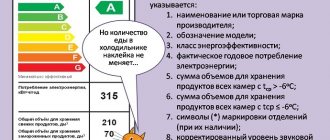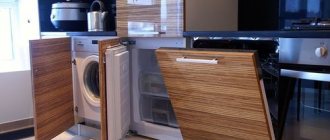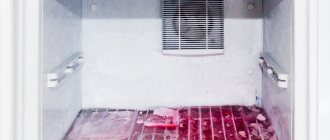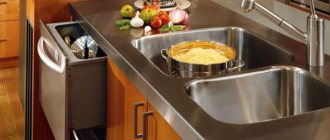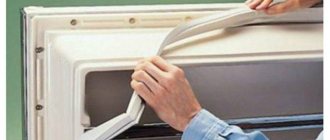What are the dangers of hot food in the refrigerator?
Some people think that since it is a refrigerator, it means it produces cold, but this is not true. In the process of cooling the internal area of the device, it takes away heat. As a result of this, if you remember physics, cooling occurs inside the refrigerator. And if you put a pan with hot food in the refrigerator, the volume of heat increases significantly, which is unacceptable.
Products with odor
If the device is powerful and there are a lot of products in it , then nothing bad will happen from one container with hot food. If there is not much food and the unit is low-powered , then the heat will begin to dissipate throughout the chamber. Products lying nearby will heat up 5°-10° above normal and become unusable.
In a situation with a strong refrigerator and a large supply of food, the temperature of the food will rise by 1 ° 2 ° - this is normal. You need to know this and the question of whether you can put hot food in the refrigerator will disappear.
Also, if you put hot food in the refrigerator, it will lose all its beneficial properties. This applies to units with a rapid cooling system (Samsung, Atlant). And food placed in plastic containers may be completely harmful to health.
Frost formation
If dishes containing hot food are not covered tightly, steam will escape. In the confined space of the cell, he will not go anywhere. Having turned into small drops of water, it will settle on the walls and turn into frost. Here you will have to unplanned defrost, otherwise the unit will not work stably.
Damage to dishes
Those in a hurry to cool hot food faster may be in for an unpleasant surprise. Due to sudden changes in temperature, chips or cracks will appear on the dishes. What's worse, it may simply burst and other products will suffer. Glass shelves will also not be happy when a hot container is placed on them.
Wear and tear of equipment
What else will happen if you put hot soup in the refrigerator? Compressor wear may occur. In refrigerators with an inverter system, it operates on a constant basis, but at low speed. In non-inverter versions, the compressor works intermittently so that the chambers always have the right temperature.
Due to excessive load, unpleasant things can happen:
- Broken freon pipes.
- Burnt out light bulb.
- In refrigerators with the No Frost function, fans may break .
If the refrigerant overheats, the energy consumption of the refrigerator will skyrocket and the food will be poorly cooled.
Overconsumption of electricity
All refrigerators have a temperature sensor. The operation of the compressor, its switching on and off, also depends on it. If there is hot food in the chamber, the temperature in it tends to be high and the compressor operates more intensively.
For inverter units, the compressor operating speed is, in this case, higher. Ordinary refrigerators generally operate continuously. To cool a three-liter pan of hot soup, the refrigerator needs to use 74-99 W more electricity than usual. If you forget, you can put something hot in the refrigerator a couple of times. But if you do this constantly, the electricity bill at the end of the month can be upsetting.
Danger of damage
Modern refrigerators are equipped with glass shelves and plastic partitions. Placing hot dishes on a shelf is fraught with cracks caused by temperature changes. The plastic covering may become deformed if it comes into contact with a hot container. Such an embarrassment can happen in inexpensive refrigerators. The plastic there is not of high quality.
You need to prepare for the fact that in such a situation, no one will do repairs under warranty. The shelves or partitions have deteriorated due to improper use, which means the warranty card is invalid.
Overconsumption of electricity
Any refrigerator has a built-in temperature sensor. It affects the frequency of switching on and the intensity of operation of the compressor. When you put hot or warm food in the refrigerator, the temperature in the refrigerator rises sharply. And he is forced to work more intensively.
For refrigerators with an inverter-type compressor, the operating speed of the latter increases. For ordinary ones, it starts working continuously. Due to this, the energy consumption of the refrigerator increases. Let's look at this with a simple example:
Example
You put a 3-liter pot of hot soup in the refrigerator at a temperature of +90 degrees. To cool it to +5, it is necessary to “take away” 255 kilocalories of thermal energy. This is the equivalent of 0.296 kW.
The COP of modern climate control equipment is 3-4 units. That is, the refrigerator will consume 74-99 watts more electricity.
In principle, not such a large amount of electricity needs to be spent. But if you constantly put hot food in the refrigerator, a significant amount can come out in a month.
How does the No frost system react to hot weather?
Don't think that high-tech refrigerators are difficult to damage. The question of whether warm soup can be placed in the refrigerator is also relevant for units with the No Frost system. In No Frost, cold air is supplied by fans, and in conventional appliances, this is done by a cooling circuit on the rear wall.
The only thing that an “anti-freeze” refrigerator benefits from is that there is no ice formed on the walls of the chambers. The No Frost function will not allow this to happen. But hot food inside the unit can have an equally bad effect on the operation of both refrigerators.
Types of units
In the old days, the question of whether it was possible to put hot food in the refrigerator was not even raised. Although our ancestors also had a “chest freezer”, or glacier. The prototype of modern technology was a large tub hidden in the underground, littered with pieces of ice. Pots of food were lowered into it to preserve food from spoilage.
Since it was impossible to get pieces of ice in spring and summer, the “refrigerator” was treated with care. Only completely cooled food, the temperature of which was no longer different from room temperature, was put into the tub.
Modern refrigerators look nothing like a tub of ice, but the ban still applies today. Why can't you put hot foods in the refrigerator? Maybe it's just a prejudice?
Two operating systems
To understand what will happen if you put hot food in the refrigerator, you need to understand how a modern cooling device works. Manufacturers have provided the consumer with equipment that operates according to one of the following two systems:
- Drip. She is sometimes called "crying". The temperature reduction in the unit is dictated by a special coolant. This refrigerant circulates in the back wall of the refrigerator. Due to the movement of the liquid, the surface is cooled, and the temperature in the refrigerator itself gradually decreases. The food inside the unit contains some moisture. This leads to the formation of persistent condensation on the walls. The latter, in the process of further cooling, turns into snow deposits. The refrigerator motor does not run continuously, and when it turns off, the temperature rises slightly. The frost begins to melt. Drops of water flow down the back surface into a special compartment.
- No frost. Such aggregates do not form glaciation on the rear surface. They do not operate using refrigerant, but using special cooling air flows. Fans are built into the refrigerator. They disperse cooled air throughout all chambers. Unlike units with a drip system, No Frost ensures fast and uniform cooling of all products.
There is a version that hot food should not be placed in a refrigerator that operates using the drip cooling method. And household appliances with the “no frost” system can easily withstand such changes. This is a misconception. Hot food harms both the first and second devices.
When can you put hot food in the refrigerator?
Some refrigeration appliances allow you to store hot food. But only if the design has dense chambers specially adapted for this. There may also be sections for quick freezing .
A separate chamber for hot food will prevent warm air from leaking into other compartments. There will be fewer problems, but more electricity will be consumed.
Hot food placed in the fast freezing compartment will cool down quickly. Warm air currents will not disperse throughout the remaining main sections of the refrigerator. But again, the compressor will start working at the limit and excessive consumption of electricity is guaranteed.
What about the warranty?
Many manufacturers of refrigeration equipment indicate in the instructions the maximum temperature of products that can be placed in it . If you have a habit of putting hot food in the refrigerator, then the risk of damage is high. If this happens, and the device is under warranty, problems may arise.
Specialists at the warranty center will most likely determine that the refrigerator was operating under increased load. There are two possible reasons:
- Constantly open refrigerator door;
- Placing hot foods into the chamber.
In both cases, you will be denied warranty repairs. In addition, the refrigerator will be removed from the warranty altogether. If you have to deal with replacing a light bulb, it doesn't cost that much. But if the compressor fails, replacing it can cost half the cost of the refrigerator
How to quickly and properly cool food
There are situations when hot foods or boiling water need to be cooled urgently. In such a case, it is advisable to have 2-3 kg in reserve. ice in the freezer. To cool a container of soup, do as shown below:
- put ice in a basin or other of suitable size
- place a pan in a basin, preferably without a lid , pour the remaining ice around the edges;
- cold water into a container with ice ;
- install all this outdoors or on the balcony;
- Remove any ice that has started to melt in the basin and replace it with fresh one .
Rapid wear
The heart of the refrigerator is the compressor (some call it the motor). This is its most important and expensive element. In inverter refrigerators it works constantly, but at a low speed. In non-inverter ones, it periodically turns on and off. This is necessary to maintain the desired temperature.
When the temperature in the refrigerator compartment rises due to hot food, the compressor begins to work with greater intensity . Depending on the type of refrigerator and compressor power, this can last from 1 to 3 hours.
At this time, the compressor is subject to increased load. Accordingly, it wears out faster, which can significantly affect its service life. For example, if the compressor of a conventional refrigerator runs continuously for an hour, this will reduce its overall operating life by 6-8 hours .
In addition, the following can happen due to a sharp increase in load:
- The light bulb will burn out;
- Due to the elevated temperature, the freon line may break;
- In No Frost systems, fans may fail;
- Due to freon overheating, the refrigerator will consume a lot of electricity, but will not cool food well.
To what temperature should food be cooled?
It is advisable to cool the food to room temperature. The recommended range may be around 35-40 degrees. To prevent dishes from becoming unusable and food spoiling, hot food must be cooled before placing it in the refrigerator. Only after this can you put it in the chamber.
If there is a special sealed compartment for hot foods , then the owners of such refrigerators have nothing to worry about. For them, the question of whether it is possible to put warm food in the refrigerator is not so pressing. But it’s still not worth abusing such an advantageous state of affairs. No matter how advanced the refrigerator is, constantly storing hot dishes in it will not lead to anything good.
A little physics
The principle of operation of a refrigerator is as follows - it does not produce cold, but takes away heat. That is, by cooling the internal space, it takes away its thermal energy. And it transmits it through the radiator on the rear wall.
If you put warm or hot food in the refrigerator, the amount of heat in the refrigerator increases dramatically. Accordingly, it needs to be taken out of the chamber and moved outside. And this increases the load on him.
Whether you can put hot food in the refrigerator depends on the situation. If it is necessary, then yes. But putting hot food in the refrigerator means harming not only it. We will talk about this below. Read carefully and do not make mistakes !
Fur coat on the walls
If you place an uncovered container of hot food in the refrigerator, water will evaporate rapidly from it. It will settle on the back wall and freeze . A so-called “fur coat” will appear – ice on the wall.
Because of such a fur coat, the refrigerator begins to absorb heat worse. Accordingly, energy consumption and equipment wear will increase. In addition, you will have to defrost the refrigerator periodically.
Ice coat on the back wall of the refrigerator
Why not and what will happen
The instruction manual says not to put hot food in the refrigerator. The manufacturer warns of a reduction in the service life of the device in case of violation of the rules of use. First you need to cool the product to room temperature. Then the food will be better preserved and the equipment will last for many years. To answer the question of why hot foods should not be placed in the chamber of a cooling appliance, several aspects need to be considered.
Wear and tear of equipment
What if you put it on hot? Is it true that equipment can break down? In order to understand the issues, you should study the principle of operation of the cooling device. Of the two most common freezing systems (drip and “No frost”), No Frost is more resistant to such loads. But over time, if you often practice cooling hot soup, the equipment will initially cool worse and eventually refuse to perform its functions. When the temperature in the device rises, the motor receives a signal that it needs to work beyond normal and fails prematurely.
Bad influence
The second question concerns the freshness of food already in the refrigerator. If you place a hot pan in the compartment, it will immediately begin to release heat and steam. This will have a detrimental effect on the stored food. It heats up again, then begins to cool again. This is especially harmful for perishable foods, such as dairy products, chilled meats, etc. Some foods under these conditions may develop harmful bacteria, the consumption of which can cause illness.
Change in taste
Does the taste of the hottest dish placed in the refrigerator change? Yes. Housewives know secrets that prohibit quickly cooling dishes. For example, milk that has not cooled down will curdle and baked goods will settle. This is the most common knowledge, but not everything. Some housewives argue that the dish must cool at room temperature, otherwise it will not infuse and its aroma will disappear. Therefore, before putting hot foods in the refrigerator, you should be aware of possible changes in their taste and aroma.
Frost formation
When the housewife decides to put unrefrigerated dishes in the refrigerator, they begin to intensively release heat and steam, resulting in condensation. It has a detrimental effect on the operation of the device, especially with a drip system. First, frost forms on the rear wall, and then a crust of ice appears, which can lead to overheating of the motor and equipment breakdown. In the best case, you will have to carry out an unscheduled defrosting of the device. With the “No frost” system the situation is better: there is no frost formation, but there is an additional load if you constantly put hot dishes in the refrigerator.
Damage to dishes and shelves
In addition to the main reasons, there are others that not everyone pays attention to. Each buyer chooses household appliances not only by technical characteristics, but also by internal contents: some prefer glass shelves, others prefer metal grilles. But they can spoil if you put a hot pan. The top layer of the gratings may melt and become unusable. Shelves, even if they are made of tempered glass, can shatter. Your favorite cup and other utensils may also become damaged. Due to sudden temperature changes, the enamel cracks and the paint chips.
Let's sum it up
Let's look at the main reasons why you should not put hot food in the refrigerator:
- Increased electricity consumption;
- Risk of breakdowns due to increased load;
- Rapid wear of the refrigerator compressor;
- Risk of damage to shelves and walls;
- Formation of an ice coat on the back wall;
- Possibility of food spoilage;
- Loss of food taste;
- The risk of being left without a guarantee.
Now you understand why you can’t put hot food in the refrigerator. We hope that the article was useful to you. You can ask your questions in the comments. Don't forget to share the post with your friends!
Do you want to get help from a master, a specialist in this field? Go to the professional search portal. This is a completely free service where you will find a professional who will solve your problem. You do not pay for posting an ad, views, or choosing a contractor. If you are a master of your craft, then register on Pro and receive a flow of clients. Your profit is just one click away!
What to do if you need to quickly cool food?
It happens that food still needs to be cooled quickly. There is a much more effective way than just putting it in the refrigerator. To do this, you must always keep 2-3 kilograms of ice in the freezer.
For example, you need to cool a pot of soup in order to put it in the refrigerator. To do this, do the following:
- Take a large container, for example a basin;
- Line the bottom with ice;
- Place a saucepan in it without a lid and add ice around the edges;
- Fill the container with cold water;
- Take everything out into the fresh air, preferably in the wind;
- As the ice melts and the water warms up, change it to cold.
When the food temperature drops to 30-40 degrees, you can safely put it in the refrigerator. It won't cause any significant problems.
Useful tips: how to quickly cool hot foods before placing them in the refrigerator
If you still need to urgently place freshly prepared food in the refrigerator, it should be cooled to room temperature. You can do this in several ways:
- in the warm season, you can wrap the pan in a towel soaked in heated water and place it in the open air for at least 15 minutes. As the liquid evaporates, the temperature of the food will decrease;
- You can simply put a pan of hot water in cold water. But it should be remembered that for enamel and glassware this can result in cracks.
- Another option is to place a closed container with food under running cold water, turning it off periodically to stir the contents;
An interesting way is to use an ice shovel. It is used in catering establishments and looks like a plastic spatula with a long handle filled with water. The device is frozen before use. By the way, you need to use it with a glove so as not to freeze your hand. Use this spatula to quickly stir soup or borscht. This method allows you not to dilute the first dish with melted water and at the same time effectively cool it.
Of all the proposed methods, I most often use cooling in a container of cold water. The main caveat here is that the cool liquid must be at least on the same level as the hot contents of the dish. It doesn’t matter how much food is in the pan or tray - in about half an hour, boiling water can cool to the temperature of the water in the surrounding container.
Experienced observations
Even if the refrigerator is equipped with a No Frost cooling system, when there is no ice on the inner rear wall, and fans disperse air flows through the chambers, therefore even hot soup will quickly cool down. However, this position cannot be abused, because there is a large load on the motor, disrupting the operation of the entire unit.
Condensation forms on open plates with soup and other dishes, which leads to damage to the product and a change in taste. If you just need to put hot soup in the refrigerator, then you need to cover it with an airtight lid.
Danger of damage
Modern refrigerators have shelves made of glass with plastic trim. And all the side compartments and walls are made of plastic.
When you place a hot pan on a glass shelf, there is a risk that it will crack due to temperature changes. If hot dishes touch the plastic, it may become deformed. Budget class refrigerators are especially guilty of this.
In both cases, you are unlikely to receive repairs under warranty. It is better not to contact the warranty center at all, as your equipment may be completely removed from the warranty.

